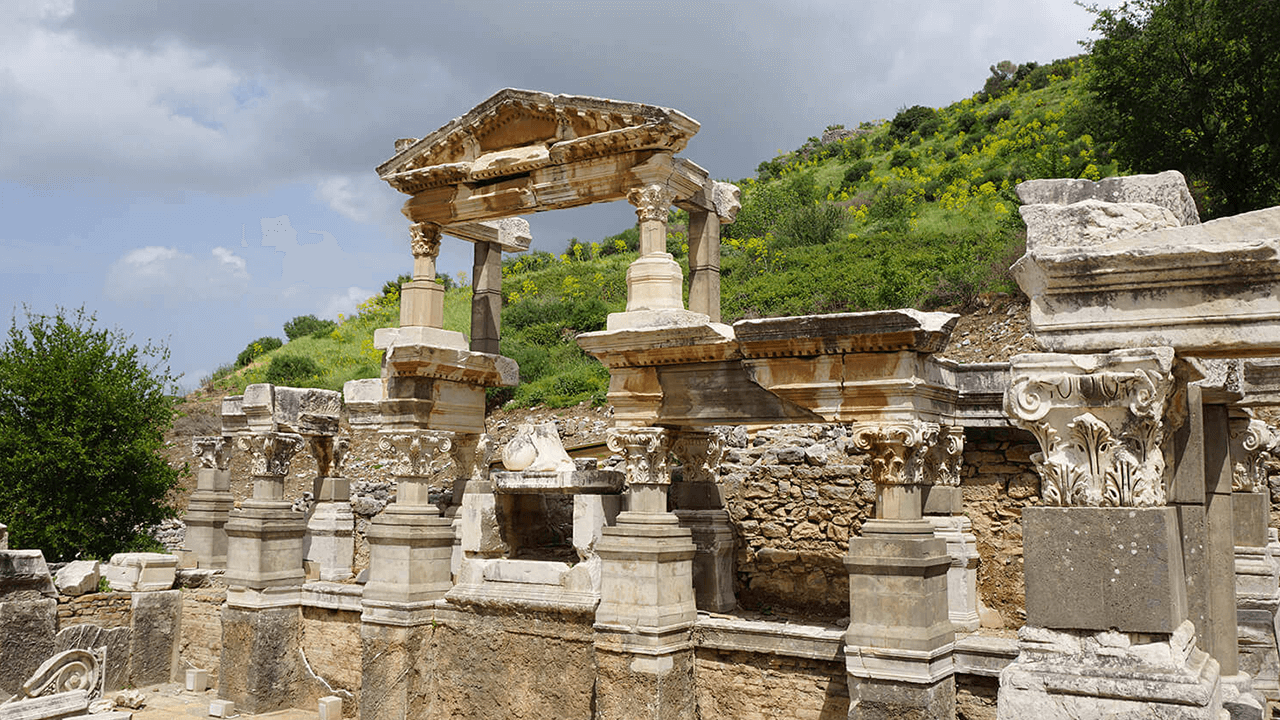The Fountain of Trajan: A Majestic Monument in Ephesus
Built around 104 AD, the Fountain of Trajan is one of the most remarkable monuments of ancient Ephesus. This spectacular structure was erected in honor of Emperor Trajan, one of the most significant rulers of the Roman Empire. With its impressive architecture and artistic richness, the fountain has become a symbol of the cultural sophistication and imperial devotion of its time.
History and Purpose of the Fountain
The Fountain of Trajan was designed to highlight the importance of Emperor Trajan and his legacy. In the central niche of the façade stood a statue of Trajan overlooking a decorative pool. This monument was not only a tribute to the emperor but also a showcase of the Roman commitment to public art and architecture.
Emperor Trajan and His Influence
Trajan was one of Rome’s most prominent emperors, known for his military conquests and infrastructure projects. The Fountain of Trajan reflects his significance as a leader and symbolizes the respect and admiration the inhabitants of Ephesus held for him.
Design and Architecture of the Fountain
The Fountain of Trajan was constructed around a pool measuring 20 x 10 meters, surrounded by columns and adorned with statues representing mythological figures and members of the imperial family. This monumental design is an impressive example of the combination of functionality and aesthetics characteristic of Roman architecture.
The Pool and Its Decoration
The fountain’s pool not only served as a decorative element but also as a symbol of wealth and prosperity. The statues surrounding the pool included representations of Dionysus, Satyrs, Aphrodite, and members of the emperor’s family, reflecting the interplay of mythology, politics, and daily life in ancient Rome.
Statues and Decorative Elements
The original statues that adorned the fountain have been moved to the Ephesus Museum, where they are displayed as outstanding examples of Roman art. These sculptures not only enhanced the monument’s beauty but also told mythological stories and exalted the figure of Emperor Trajan.
The Statue of Trajan
The statue of Trajan, located in the central niche of the façade, was the focal point of the fountain. Its dominant position symbolized the emperor’s authority and leadership, while its presence reinforced the connection between imperial power and daily life in Ephesus.
Current State and Restoration
Although the restoration of the Fountain of Trajan is not yet complete, the monument remains one of the main attractions of Ephesus. The remaining structures and decorative elements allow visitors to imagine the fountain’s original grandeur.
A Work in Progress
The restoration work aims to preserve and reconstruct this unique monument, ensuring future generations can admire its beauty and learn about the history of Ephesus. As excavations and conservation efforts progress, new details about the fountain’s construction and use continue to emerge.
Cultural and Touristic Significance
The Fountain of Trajan is not only a testament to Roman art and architecture but also a reminder of the cultural and political influence of Ephesus in the ancient world. This monument is a highlight for visitors seeking to explore the history and legacy of this iconic city.
A Place for Reflection and Admiration
Visiting the Fountain of Trajan offers tourists a chance to reflect on the grandeur of ancient Rome and appreciate the skill of the architects and artists who created this impressive monument. It serves as a reminder of Trajan’s power and influence, as well as the cultural richness of Ephesus.
Tips for Visiting the Fountain of Trajan
- Location: The fountain is located in the heart of the Ephesus ruins, near other major attractions such as the Temple of Hadrian.
- Recommended time: Visiting early in the morning or late in the afternoon allows you to enjoy the site with fewer crowds and better lighting for photographs.
- Respect the site: As an archaeological site under restoration, it is important not to touch the structures or interfere with protected areas.
Conclusion
The Fountain of Trajan is an architectural jewel of ancient Ephesus that stands out for its monumental design and historical significance. This tribute to Emperor Trajan reflects the grandeur of the Roman era and the importance of Ephesus as a cultural and political center. Visiting this site is a unique opportunity to delve into history and admire the sophistication of ancient art and architecture.














3 thoughts on “The Fountain of Trajan”
★★★★★
Visiting ‘The Fountain of Trajan’ was an extraordinary experience, offering insights and enjoyment like no other. Highly recommended!
★★★★★
I was blown away by everything ‘The Fountain of Trajan’ has to offer. Definitely a place to return to in the future.
★★★★★
The charm of ‘The Fountain of Trajan’ captivated me entirely. It’s a destination that leaves no one indifferent.